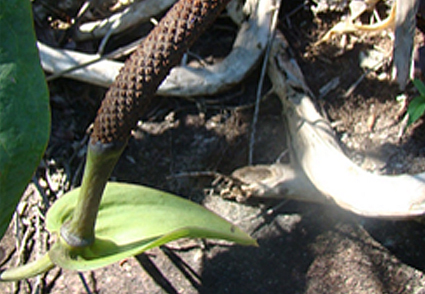Abstract
A remarkable new species of Anthurium, named A. capixaba, is here described and compared to its closest relatives. We also present an amended description of A. marcusianum based on the recently fruiting specimens collected.
References
- Backeberg, C. (1942) Cactaceae. Lindley: Systematische Übersicht (Neubearbeitung) mit Beschreibungeschlüssel. In: Jahrbücher der Deutschen Kakteen-Gesellschaft. Verlag J. Neumann, Neudamm.
- Bentham, G. (1876) Gesneriaceae. In: Bentham, G. & Hooker, J.D. (Eds.) Genera Plantarum ad exemplaria imprimis in herbariis Kewensibus 2: 990–1025.
- BFG. (2018) Brazilian Flora 2020: Innovation and collaboration to meet Target 1 of the Global Strategy for Plant Conservation (GSPC). Rodriguésia 69: 1513–1527. https://doi.org/10.1590/2175-7860201869402
- Bown, D. (2000) Aroids: Plants of the Arum family. Timber Press, Portland, Oregon. 392 pp.
- Boyce, P.C. & Croat, T.B. (2020 onwards) The Überlist of Araceae, Totals for Published and Estimated Number of Species in Aroid Genera. Available from: http://www.aroid.org/genera/180211uberlist (accessed 1 March 2021).
- Cardozo, A.P., Temponi, L.G., Andrade, I.M., Mayo, S.J. & Smidt, E.C. (2014) A morphometric and taxonomic study of Anthurium augustinum complex (Araceae), endemic to the Brazilian Atlantic Forest. Feddes Repertorium 125: 43–58. https://doi.org/10.1002/fedr.201400025
- Carlsen, M.M. & Croat, T.B. (2013) A molecular phylogeny of the species-rich neotropical genus Anthurium (Araceae) based on Combined Chloroplast and Nuclear DNA. Systematic Botany 38: 576–588. https://doi.org/10.1600/036364413X670287
- Carlsen, M.M. & Croat, T.B. (2019) An analysis of the sectional classification of Anthurium (Araceae): comparing infrageneric groupings and their diagnostic morphology with a molecular phylogeny of the genus. Annals of the Missouri Botanical Garden 104: 69–82. https://doi.org/10.3417/2018215
- Chautems, A., Peixoto, M. & Rossini, J. (2015) A new species of Sinningia Nees (Gesneriaceae) from Espírito Santo and Rio de Janeiro states, Brazil. Candollea 70: 231–235. https://doi.org/10.15553/c2015v702a8
- Coelho, M.A.N. & Valadares, R.T. (2019) Three new species of Anthurium (Araceae) from the Atlantic Forest of Rio de Janeiro, Minas Gerais, and Espírito Santo, Brazil. Novon 27: 22–32. https://doi.org/10.3417/2019267
- Coelho, M.A.N., Waechter, J.L. & Mayo, S.J. (2009) Revisão taxonomica das espécies de Anthurium (Araceae) seção Urospadix subseção Flavescentiviridia. Rodriguésia 60: 799–864. https://doi.org/10.1590/2175-7860200960407
- Couto, D.R., Manhães, V.C. & Costa, A.F. (2020) Stigmatodon attenuatoides (Tillandsioideae, Bromeliaceae): a new mat-forming species on inselbergs of southeastern Brazil. Phytotaxa 468: 143–149. https://doi.org/10.11646/phytotaxa.468.1.11
- Croat, T.B. & Bunting, G.S. (1979) Standardization of Anthurium descriptions. Aroideana 2: 15–25.
- Croat, T.B. (1980) Flowering behavior of the neotropical genus Anthurium (Araceae). Amer. J. Bot. 67: 888–904. https://doi.org/10.2307/2442430
- Engler, H.G.A. (1905) Araceae-Pothoideae. In: Engler, A. (Ed.) Das Pflanzenreich. W. Engelman, Leipzig & Berlin, pp. 1–330.
- Engler, H.G.A. (1878) Araceae. In: Martius, C.F.P. (Ed.) Flora Brasiliensis 3: 56−88.
- Gonçalves, E.G. (2011) Philodendron bernardopazii and P. ricardoi spp. nov. (Araceae) from Espírito Santo State, Brazil. Nordic Journal of Botany 29: 385–390. https://doi.org/10.1111/j.1756-1051.2011.01103.x
- Gouda, E. & Till, W. (1997) Aechmea maasii: uma nova espécie do Brasil. Bromélia 4: 4–9.
- Ker Gawler, J.B. (1819) The Botanical Register : consisting of coloured figures of exotic plants, cultivated in British Garden with their history and mode of treatment. Vol. 5. James Ridgway: Piccadily, London.
- Mayo, S.J., Bogner, J. & Boyce, P.C. (1997) The Genera of Araceae. Royal Botanic Garden, Kew, London, 370 pp. https://doi.org/10.1007/978-3-662-03531-3_7
- Miquel, F.A.W. (1838) Plantarum Cactearum, in Flora Fluminensi Delineatarum, Revisio. Bulletin des Sciences Physiques et Naturelles en Néerlande 1838: 47–49.
- Regel, E.A. von & Schmidt, E.I. (1880) Originalabhandlungen. Gartenflora 29: 97–98, pl. 1005.
- Robyns, A. (1963) Essai de Monographie du genre Bombax L. s.l. (Bombacaceae). Bulletin du Jardin Botanique de l’état, Bruxelles 33: 1–315. https://doi.org/10.2307/3667210
- Schott, H.W. (1829) Für Liebhaber der Botanik. Wiener Zeitschrift für Kunst, Litteratur, Theater und Mode. Vienna, 828 pp.
- Schott, H.W. (1860) Prodromus Systematis Aroidearum. Vindobonae Typis congregationis Mechitharisticae, Vienna, 602 pp.
- Smith, L.B. (1943) Bromeliáceas novas ou interessantes do Brasil – II. Arquivos de Botânica do Estado de São Paulo 1: 102–122, tab. 101–134.
- Stearn, W.T. (2004) Botanical Latin. Timber Press, Portland.
- Temponi, L.G. (2006) Sistemática de Anthurium sect. Urospadix (Araceae). Ph.D. Thesis, Instituto de Biociencias, Universidade de São Paulo, São Paulo.
- Temponi, L.G., Garcia, F.C.P., Sakuragui, C.M. & de Carvalho-Okano, R.M. (2005) Diversidade morfológica e formas de vida das Araceae no Parque Estadual do Rio Doce, Minas Gerais. Rodriguésia 56: 1–13. https://doi.org/10.1590/2175-78602005568801
- Uribbe, F.P., Neves, B., Jacques, S.S.A. & Costa, A.F. (2020) Morphological variation in the Vriesea procera complex (Bromeliaceae, Tillandsioideae) in the Brazilian Atlantic Rainforest, with recognition of new taxa. Systematic Botany 45: 53–68. https://doi.org/10.1600/036364420X15801369352306
- Valadares, R.T., Kollmann, L.J.C. & Sakuragui, C.M. (2019) New species of Anthurium (Araceae) with cordate leaves from Southeastern Brazil. Novon 27: 3–7. https://doi.org/10.3417/2018270
- Veloso, E.M., Rangel-Filho, A.L.R. & Lima, J.C.A. (1991) Classificação da Vegetação Brasileira, Adaptada a um Sistema Universal. IBGE, Departamento de Recursos Naturais e Estudos Ambientais, Rio de Janeiro.
- Versieux, L.M. & Wanderley, M.G.L. (2007) A new species of Alcantarea (É. Morren ex Mez) Harms, Bromeliaceae. Hoehnea 34: 409–413. https://doi.org/10.1590/S2236-89062007000300009
- Wiehler, H.J. & Chautems, A. (1995) Reduction of Lietzia to Sinningia. Gesneriana 1: 5–7.


